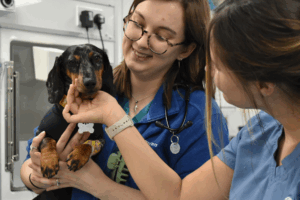As we head into spring, it’s a crucial time to be aware of ticks, which are most commonly found between the spring and autumn months. These common parasites can pose threats to your pets and family if left untreated.
In this article, we’re sharing how you can identify and safely remove ticks from dogs and cats (as well your other pets!) to help protect them from infections like Lyme disease.
Understanding ticks
Ticks are small, spider-like parasites that have eight legs and an egg shaped body. They are typically found in long grass and woodland areas.
Unlike fleas, they don’t jump, but will latch onto your pet’s fur if they brush past. They can feed on their blood for a few days before dropping off once they’ve had enough. However, during this time, there’s a risk the tick could transmit a disease to your pet.
Spotting ticks
It’s important to check your pet’s fur regularly for ticks, paying close attention to areas like their ears, neck and paws.
You may notice ticks become darker in colour, as they feed on your pet’s blood.
How to remove ticks safely
When removing a tick, make sure you don’t squeeze the tick’s body or leave the head in, as this can push blood back into your pet and increase the chance of infection or disease transmission.
If you see a black spot, redness or swelling where the tick was located, it is likely the tick was only partially removed. In these cases, there is a higher risk of infection, so it’s best to book an appointment with your vet to get your pet checked over.
Use a tick removal tool
To avoid causing the tick to split, you’ll need to twist it off. This can be done easily using a tick removal tool, widely available at vets and pet shops.
Some people try to burn ticks off, or use lotion to suffocate them; we strongly advise against this. These methods can harm your pets and will not prevent disease.
Easy to follow steps for tick removal
Step 1: Slide a tick remover under the tick
- Slide a tick remover under the tick, keeping as close to your pet’s skin as possible.
- If the tool doesn’t fit closely, try a different size (packs usually come with 2 or 3 different size options).
- If you don’t have a tick remover, you can carefully use ordinary tweezers. Hold the tick gently and as close to the skin as possible.
Step 2: Twist the tick
- Twist the tool in one direction, without pulling upwards, until you feel the tick loosen. It will release when you’ve turned enough.
Step 3: Remove the tick
- Slowly lift the tool away from your pet; the tick should release and remain in the hook.
- Dispose of it to prevent it attaching to other people or animals.
Step 4: Clean the area
- Clean the affected area with warm salty water.
- Monitor your pet for any signs of illness.
Look for symptoms of Lyme disease
Lyme disease is a severe bacterial infection carried by ticks. Dogs, cats and humans can all get Lyme disease, although it’s rare in cats.
Symptoms to look out for include (but may not be limited to):
- Loss of appetite
- Fever
- Lethargy
- Swollen and painful joints
- Swollen lymph nodes
- Lameness
- Depression
Treatment for Lyme disease
Lyme disease can be treated with antibiotics, if detected early. If you are concerned that your pet may have Lyme disease or is showing any of the listed symptoms, contact your vet immediately for tests and prompt treatment.
Preventing ticks
It’s possible to protect your pet from ticks. With different types of preventative tick treatments, such as spot-on treatments and tablets available, that kill or repel ticks if they attach themselves.
Tick treatment is included with our Pet Healthcare Plus Plans, with products delivered straight to your door. Our Plus Plans also cover:
- Annual vaccinations
- Six monthly health checks
- Flea and worming products
- Unlimited nail trims
- Discounts on selected services at St Kitts Vets
- Free microchip (if required)
To find out more about our Pet Healthcare Plans, click here.
If you are worried about removing the tick yourself, or have concerns about your pet’s health, contact your local St Kitts practice immediately:
St Kitts Vets Hartley Wintney: 01252 844044
St Kitts Vets Basingstoke: 01256 844944
Crookham Park Veterinary Centre: 01252 913990
Firgrove Veterinary Centre: 01252 877799





